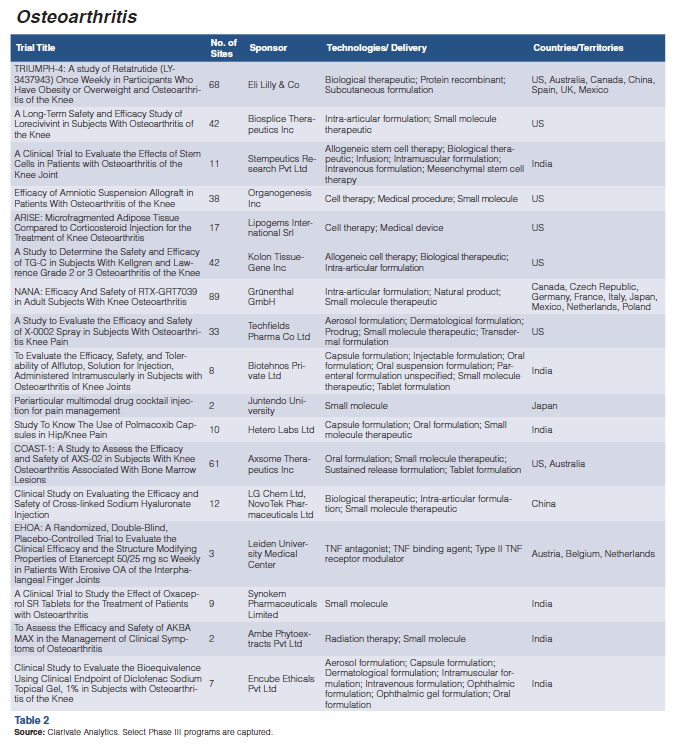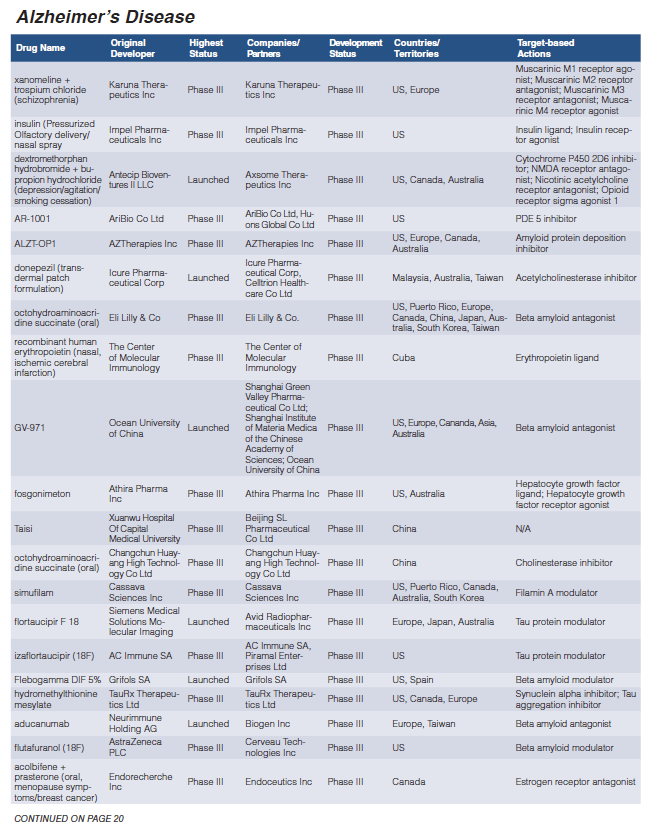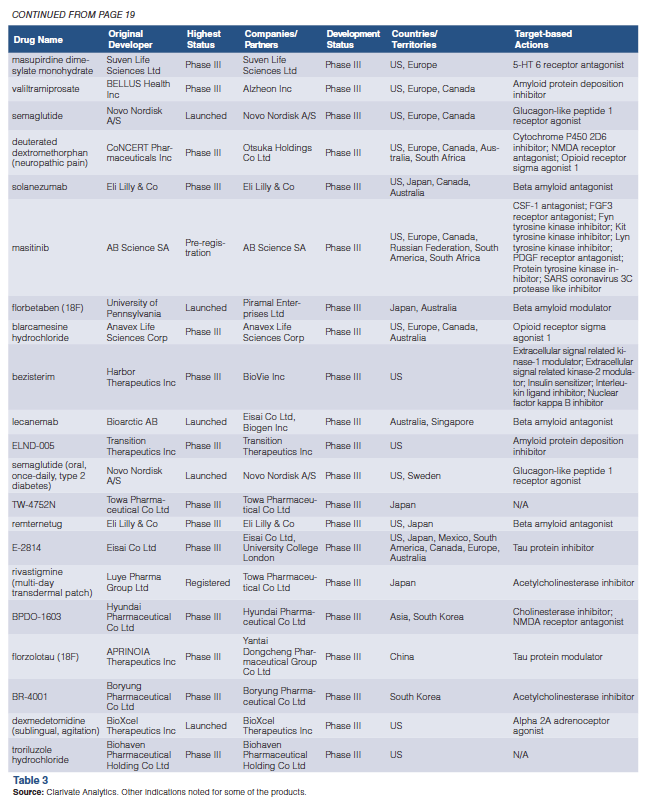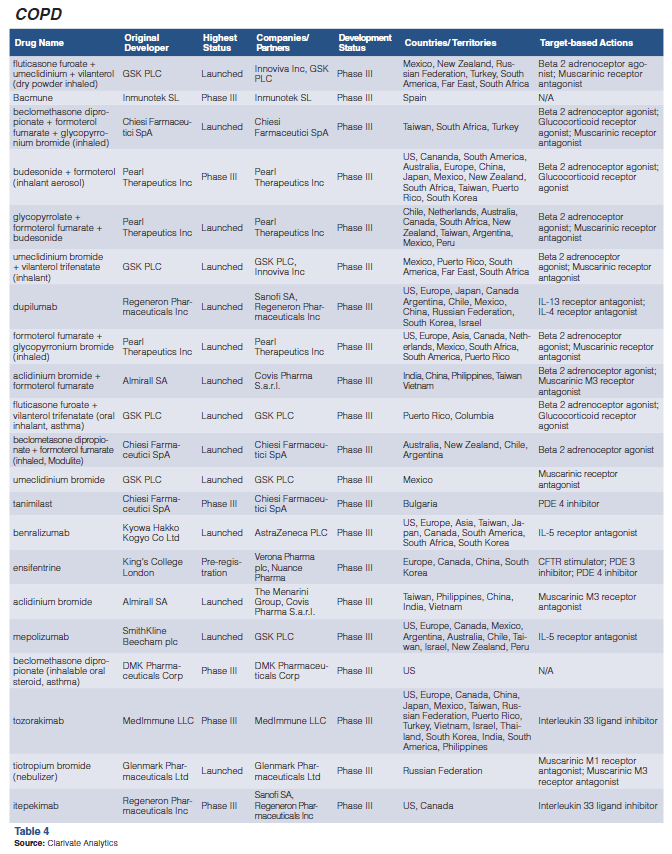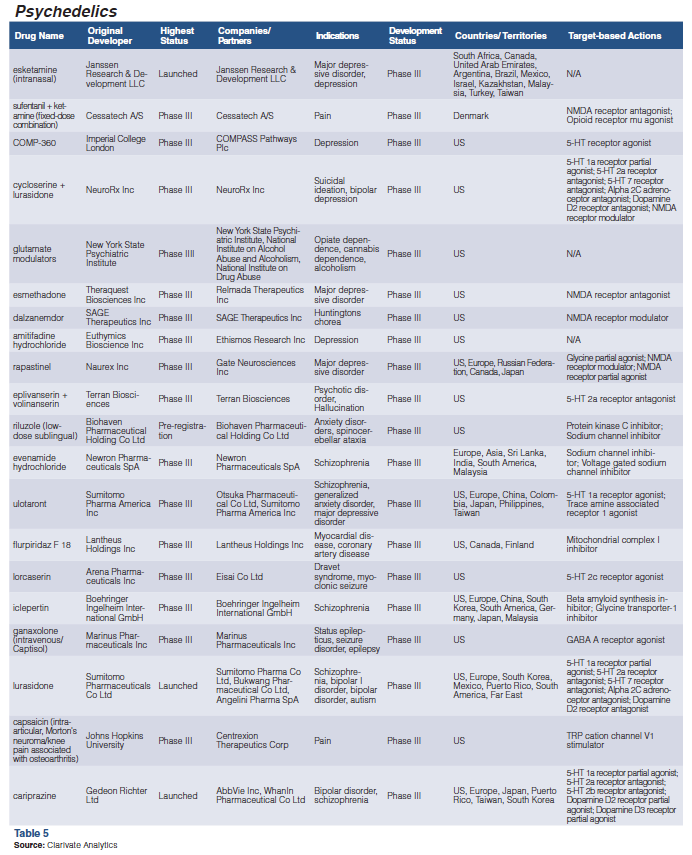Recent innovation in pharmaceuticals has prioritized so-called “first-world problems”; that is, disease areas primarily affecting wealthy countries. Emerging or novel drugs are often designed to target some of the most stubborn ailments, or disease settings, in first-world nations—with new products iterating on past successes and focused on improving patient quality of life. Demographics aside, biopharma companies have achieved notable and substantial breakthroughs in these therapeutic areas, as new advances in particular in the categories of weight loss, osteoarthritis, Alzheimer’s disease, chronic obstructive pulmonary disease (COPD), and psychedelics demonstrate leaps forward in efficacy, tolerability—or both. Pharm Exec’s 19th Annual Pipeline Report dives into the most promising innovations in these five disease areas, with supporting data provided by Clarivate Analytics.
Tables Compendium: Drugs in Late-Stage Development
The data tables arranged throughout this article capture respective snapshots of product candidates in Phase III development (as of late September) in the five therapeutic settings highlighted in the preceding analysis: weight loss, osteoarthritis, Alzheimer’s disease, chronic obstructive pulmonary disease (COPD), and psychedelics. The listings, provided by data intelligence company Clarivate Analytics, include drugs that have previously launched but are actively being evaluated in Phase III clinical trials for new or expanded indications, new patient populations, approval in new geographies, etc. The data provided in the charts does not purport to represent complete datasets. All data are based on specific remit and search criteria. Clarivate Analytics and Pharmaceutical Executive do not make any warranties or representations regarding the completeness of the data presented.
WEIGHT-LOSS DRUGS GAIN MOMENTUM
Obesity treatments have entered the mainstream in recent years, with major breakthroughs in glucagon-like peptide-1 (GLP-1) receptor agonists attracting investment in new research. Clarivate data shows over 350 weight-loss drug candidates currently in various phases of development, with many of them in Phase III clinical trials.
Several of these therapies are being repurposed from other indications such as non-alcoholic fatty liver disease or diabetes, and their mechanisms of action range from peptide agonists to insulin sensitizers and beyond.
Sara Mallatt Stahl, director of research, healthcare at Stream by AlphaSense, says weight-loss drugs have attracted a buzz not seen in other areas.
“People know these drugs by name,” she tells Pharm Exec. “The breakthrough came in 2018, but the momentum has taken off in the last year or two. These GLP-1s slow stomach emptying, so patients feel fuller for longer, which facilitates weight loss.”
Mallatt Stahl says that GLP-1s were originally developed for patients with diabetes, as they also regulate insulin secretions; as the treatments evolved, though, researchers discovered the weight-loss benefits. Now, manufacturers are repurposing these diabetes medications to combat obesity.
“The drugs that are approved right now are showing 15%-20% total weight loss when utilized, which is a big change from the previous category of weight-loss drugs, which showed only 3%-4%,” notes Mallatt Stahl. “However, one major drawback is that these drugs are injectable [rather than oral].”
Mike Ward, global head of life sciences and healthcare thought leadership at Clarivate Analytics, says use and activity around GLP-1s are growing across the globe, even in unconventional places such as China. Ward says that as a result of Novo Nordisk’s branded semaglutide injection, Ozempic, the Danish-based drugmaker is now the largest pharma company in Europe.
“One of the major drivers is that people are looking for more convenient approaches to treating weight loss,” says Ward. “A lot of the first-generation products were taken more than once a day, whereas what we’re looking for is long-acting formulations. The holy grail for any medicine is something you don’t have to take too often and that is the least invasive. Orals are obviously less invasive than injectables, which are less invasive than intravenous.”
Several of the major weight-loss drugs currently on the market are injectable; Novo Nordisk’s Ozempic comes in 0.5 mg, 1 mg, and 2 mg injections, while the company’s Wegovy is a 2.4 mg semaglutide injection. Currently, in the US, Ozempic is approved as a treatment for type 2 diabetes (and is sometimes prescribed off-label for weight loss), while Wegovy is approved as an obesity treatment.
In May 2022, FDA approved Eli Lilly’s branded tirzepatide injection Mounjaro for type 2 diabetes. The drug had also been prescribed off-label for weight loss, but on Nov. 8 it was cleared by FDA to treat obesity, sold under the name Zepbound.1
These early successes in weight-loss drugs are inspiring further research and development, with a number of second-generation obesity candidates currently in the pipeline. Lilly is currently developing retatrutide, a once-weekly injection that attaches to GIP, GLP-1, and glucagon receptors; one Phase II trial on 338 overweight adults sponsored by Lilly found that 1 mg of retatrutide per day resulted in a 7.2% decrease in body weight after 24 weeks; the drop was found to be dose-dependent, with higher doses of retatrutide resulting in greater weight loss.2
Meanwhile, the search for an oral weight-loss solution continues. Novo Nordisk is currently trialing an oral semaglutide tablet; in May, the company announced Phase IIIa results demonstrating that a 50 mg tablet once per day resulted in 15.1% weight reduction in overweight and obese adults.3
Lilly is also pursuing an orally-administered option in this setting. The company’s drug candidate, orforglipron, a once-daily GLP-1 pill, is undergoing Phase III trials for both diabetes management and chronic weight management. Recently, a Phase II trial found that orforglipron resulted in up to a 14% decrease in body mass after 36 weeks, compared to just a 2.3% decrease with placebo.4
Other candidates currently in development for weight loss include danuglipron, a twice-daily pill similar to orforglipron; APH-012, a once-daily pill designed to imitate gastric bypass surgery; and bimagrumab, a monoclonal antibody infusion that blocks activin receptors.
OSTEOARTHRITIS: INCHING CLOSER TO A CURE
The most common type of arthritis, osteoarthritis (OA) is a degenerative joint condition with no cure. Now, though, emerging drug treatments are showing promise in not only reducing symptoms, but modifying the disease itself.
One 2023 study examined the effects of a recombinant Link module of human TSG-6 protein on cytokine-induced cartilage degradation in human knee cartilage cultures. The study determined that Link_TSG-6, developed by Link Biologics, inhibits aggrecanase and collagenase activity, thereby protecting cartilage. In a rodent model, Link_TSG-6 reduced pain behavior and cartilage damage.5
Another investigational drug, R805/CX-011, has been found to reduce inflammation in animal models of osteoarthritis and is moving into human clinical trials. The drug was found to modulate GP130, an immune cell receptor that instructs antibodies to attack. The animal study demonstrated that the drug can manage stiffness and pain.6
Other treatments are further along in the development pipeline. One plant-based OA drug, known as APPA, is being prepared for a Phase IIb clinical trial. APPA is a Nrf2 and NFkB modulator consisting of two synthetic plant metabolites. The drug has been shown in rat and dog models to reduce cartilage degradation, pain, and bone turnover. Phase I and II studies showed that APPA is well tolerated and generally safe for humans.7
Another Phase II trial is currently examining the efficacy of CNTX-6970, a small molecule CCR2 antagonist developed by Centrexion Therapeutics, on knee osteoarthritis pain in osteoarthritis patients aged 40 to 90. The study, estimated to be completed in May 2024, will employ a crossover design; subjects will be randomly assigned to receive CNTX-6970 or a placebo for six weeks before crossing over to the opposite condition for six weeks.8
Meanwhile, researchers at UC San Diego are studying the effects of bone marrow aspirate concentrate (BMAC) on knee osteoarthritis in a pilot open-label, non-randomized study. This pilot study began in 2020 and is estimated to be completed by the end of 2023.9
Other emerging drug candidates in osteoarthritis treatment include lorecivivint, CYP 004, JTA-004, and SMUP-IA-01. Lorecivivint is a Wnt pathway inhibitor that acts on kinase 2 and kinase 1A. While a recent Phase IIA trial failed to meet its endpoint, lorecivivint is currently undergoing Phase III studies in particular subgroups.10 One Phase III long-term extension trial on patients with knee osteoarthritis found that lorecivivint significantly improved Western Ontario and McMaster Universities Osteoarthritis (WOMAC) pain scores and WOMAC function scores compared to placebo. The study results also indicate that lorecivivint may delay structural progression of knee osteoarthritis.11
CYP-004 is a mesenchymal stem cell produced by Australian company Cynata Therapeutics. In 2020, Cynata launched the SCUlpTOR trial, a Phase III clinical study funded by the Australian Government National Health and Medical Research Council and sponsored by the University of Sydney. The trial is examining the effects of CYP-004 on knee pain and cartilage loss in knee osteoarthritis subjects.12
Developed by Bone Therapeutics, JTA-004 is a plasma protein solution containing clonidine and hyaluronic acid. The investigational drug was recently acquired by BioSenic. In March, BioSenic announced that it had reevaluated the results of its Phase III trial on JTA-004; this post-hoc analysis found that a single injection of JTA-004 was more effective than placebo at relieving pain, particularly in the subset of patients with the most painful form of osteoarthritis. The company expects JTA-004 to reach the market in 2027.13
SMUP-IA-01, developed by South Korean biotech Medipost, is an injectable mesenchymal stem cell treatment that is currently in Phase II trials. In a Phase I study, the injection was found to be safe and effective at relieving pain and improving joint function. The Phase II trial, which started in December 2021, is following 90 patients with mild-to-moderate knee osteoarthritis; subjects will receive a single injection of SMUP-IA-01 and will be followed for one year.14
TURNING A CORNER IN ALZHEIMER’S
Drugs for Alzheimer’s disease (AD) are undergoing a revolution, as the search for disease-modifying medications continues. Clarivate data shows 750 AD candidates in various stages of development. These drugs include monoclonal antibodies such as BIIB-076, a Phase I drug developed by Neurimmune Holding, as well as repurposed therapies, such as montelukast, an asthma treatment that is currently in Phase II trials for AD. Other notable drugs in clinical testing include the placenta-derived stem cell treatment CBAC-02, made by CHA Biotech, currently in Phase II trials, and NTRX-07, an investigational cannabinoid receptor agonist developed by NeuroTherpia.
Ward says that AD is an interesting space to watch, given that there is now an established route for drug approval. He explains that because the first products for AD have already been approved, the space has attracted much more interest in recent years from pharma companies.
“There was a paper published in the past few weeks that suggested the concept of cell death in Alzheimer’s patients,” notes Ward. “It’s one of those diseases we knew was a problem, but nobody had created any acceptable solutions. We’re going to see a lot more effort put into neurodegenerative diseases, so the prospects over the next decade certainly look promising.”
Ward adds that there are several products in clinical development right now, some of which appear to be disease-modifying efforts, which represents an important breakthrough. Prior AD drugs such as Aricept, he says, merely slowed disease progression; an approved, effective disease-modifying AD treatment is something of a holy grail for the life sciences industry.
One of the newest AD candidates undergoing clinical testing is zagociguat (CY6463), a CNS-penetrating soluble guanylate cyclase (sGC) stimulator. Developed by Ironwood Pharmaceuticals subsidiary Cyclerion Therapeutics, zagociguat recently underwent its first human trial, which examined the safety, pharmacokinetics, and pharmacodynamics of varying dosages of zagociguat in a group of healthy adults. The trial found that zagociguat was well-tolerated in the study group and penetrated the central nervous system, resulting in sGC stimulation. The study validated the drug’s mechanism of action, paving the way for future studies.15
Other hopeful therapies are closer to potential market entry. One Phase III clinical trial completed this year examined the effects of Lilly’s biologic drug donanemab, a monoclonal antibody that targets amyloid beta protein, in 1,736 subjects with early symptomatic AD, including mild cognitive impairment and mild dementia. Subjects were randomly assigned to receive either donanemab (n = 860) or a placebo (n = 876) intravenously once every four weeks for 76 weeks. The subjects were scored on the integrated Alzheimer Disease Rating Scale (iARDS) at baseline and on study completion; secondary outcomes included Clinical Dementia Rating Scale (CDRS) scores. After 76 weeks, the subjects in the treatment group exhibited significantly better CDRS and iARDS scores than the placebo group. The study authors concluded that donanemab slowed the clinical progression of AD.16 Lilly completed its FDA submission for approval of donanemab in July, and an agency decision is expected by the end of the year.17
Monoclonal antibodies have attracted significant attention in AD treatment, particularly since the COVID-19 pandemic. In July, FDA granted accelerated approval to the Eisai/Biogen drug Leqembi (lecanemab), an antibody intravenous infusion therapy that targets removal of amyloid beta from the brain.18 Leqembi underwent a 2023 Phase III trial on 1,795 subjects with AD; subjects were randomingly assigned to receive either 10 mg/kg of intravenous lecanemab once per day, (n = 898) or a placebo (n = 897), for two weeks. Subjects were assessed via the Clinical Dementia Rating-Sum of Boxes scale, through PET scans for amyloid plaque, on the Alzheimer’s Disease Assessment Scale, the Alzheimer’s Disease Composite Score, and the Alzheimer’s Disease Cooperative Study-Activities of Daily Living Scale for Mild Cognitive Impairment. All of the subjects were followed for 18 months. After this period, the patients receiving lecanemab exhibited significantly reduced amyloid plaque markers as well as moderately less decline on measures of cognitive function compared to placebo.19
Other notable drug candidates in development for AD include mecripyrine hydrochloride, an acetylcholinesterase and tau protein inhibitor in Phase I trials, [18F]-AM-PBB3, an investigational tau tracer in Phase II studies, and donepezil, a cholinesterase inhibitor currently in Phase I.
COPD ON VERGE OF BREAKTHROUGH?
It’s been several years since a new drug for COPD came to market. To date, the major therapies for the debilitating condition, often linked to smoking, have consisted primarily of corticosteroids, bronchodilators, methylxanthines, and biologics; these drugs typically aim to reduce symptoms.
Today, however, therapies are in the pipeline that target specific COPD biomarkers. One such candidate, dupilumab, holds promise as a disease-modifying drug for the condition. The monoclonal antibody, already a blockbuster seller, branded as Dupixent, for several indications, including atopic dermatitis and asthma, recently underwent a Phase III trial in patients with COPD with 300 blood eosinophils per microliter and an elevated exacerbation risk. In this study, subjects were randomly assigned to receive either 300 mg of dupilumab via subcutaneous injection (n = 468), or a placebo (n = 471), once every two weeks. The subjects were assessed for number of COPD exacerbations after one year, as well as for forced expiratory volume (FEV) and St. George’s Respiratory Questionnaire (SGRQ) scores at baseline and after one year. Finally, subjects had blood taken at baseline and after one year, and were assessed for blood eosinophil count. After one year, those who received dupilumab had superior lung function, a better quality of life, and fewer exacerbations than the placebo group.20
Meanwhile, several other biologics originally designed as asthma treatments are in the midst of human trials for COPD,21 including mepolizumab, benralizumab, and itepekimab. These treatments are in various stages of clinical development for COPD based on their strong effects on asthma exacerbation frequency.22
But monoclonal antibodies aren’t the only major investigational efforts underway hopeful of reshaping COPD therapy. Ensifentrine, a PDE3/PDE4 dual inhibitor, has completed two Phase III trials and has been submitted for US approval with a PDUFA date of June 26, 2024. During Phase II studies in subjects with COPD, ensifentrine was found to have bronchodilatory properties, to improve symptoms in COPD patients, and to improve quality of life. These findings held, regardless of whether ensifentrine was administered alone or in combination with other drugs.23
Combination treatments are also a growing trend in COPD research. One Phase III trial examined the effects of a triple-combination of inhaled budesonide, glycopyrrolate, and formoterol relative to dual therapies. The study found that triple-therapy resulted in a lower rate of moderate-to-severe COPD exacerbations after one year compared to dual therapy.24
Big Pharma organizations such as AstraZeneca are continuing to innovate in COPD research, having identified various proteins, such as IL-33, myeloperoxidase, and forkhead box O4, as major disease pathways.25
This primary research is illuminating potential new mechanisms of action that could warrant pharmaceutical development.
PSYCHEDELICS ATTRACT ATTENTION AND CAPITAL
Psychedelic medicine has sparked notable advances in mental health treatment, and is considered the first major innovation in the field since the rise of selective serotonin reuptake inhibitors (SSRIs) in the 1980s. While much of the research around psychedelics has been in existence since the 1970s, the Nixon Administration’s War on Drugs put a significant chill on psychedelic research for several decades. Now, though, psychedelics are once again coming to the forefront of medical research, given their promising therapeutic results.
“Psychedelics are quite hot in terms of their potential for mental health,” Ward tells Pharm Exec. “I think that’s going to be a challenge for regulators. We’re seeing a lot of venture capital going into the psychedelics space, which is a proxy for what will be hot in five or 10 years’ time.”
Clarivate data shows more than 270 psychedelic drugs currently in various stages of development. These treatments are primarily focused on mental health and addiction conditions, including depression, eating disorders, post-traumatic stress disorder, and alcoholism.
David Cavanaugh, founding partner at DeciBio Consulting in Los Angeles, says several of these drugs are now coming to market. FDA approved ketamine several years ago, he notes, and methylenedioxymethamphetamine (MDMA)-assisted therapy is slated to enter the market within the next 18 months.
“There are a lot of interesting uses for these drugs,” says Cavanaugh. “There are several challenges, though, because they’re not the typical pharmaceuticals. This model is very different because of the fact that it’s drug-assisted therapy.”
Cavanaugh explains that psychedelics enable patients to interact with their trauma in ways they couldn’t before, enabling a superior benefit of psychiatric therapy when medication and therapy are combined.
This combination approach is a new and different model for pharma companies; Cavanaugh notes that the Multidisciplinary Association for Psychedelic Studies (MAPS) protocol for MDMA requires 40 hours of therapy. He adds that therapy is required before, during, and after drug-assisted procedures; while this is very intensive and burdensome for providers, Cavanaugh says the clinical results are excellent.
“Most of the drugs in the mental health space are decades old,” he tells Pharm Exec. “If you look at drugs for PTSD, they don’t really work well. They don’t resolve the PTSD. The psychedelics are game-changing.”
Cavanaugh points to the MAPS trial as proof of psychedelics’ potential; in this study, a majority of patients on the treatment protocol no longer qualified for the definition of PTSD after treatment. However, he notes there are several barriers to entry that psychedelics face.
“The go-to-market for these drugs is quite different,” says Cavanaugh. “We have a shortage of mental health clinicians, so how do you bring these drugs to market when the therapists aren’t available? Plus, finding spaces to do the drug intervention sessions will be challenging. The sessions are eight hours long, and they’re typically done in a place with a bed so the patient can relax.”
Cavanaugh also notes that because psychedelics are controlled substances, there are significant restrictions around who can administer them. He says MDMA-assisted therapy will likely require an FDA risk evaluation and mitigation strategy (REMS) due to the addictive nature of psychedelics. Furthermore, therapists will require specialized training in administering the therapy. The most substantial barrier to access, though, will be reimbursement.
“For commercial private-pay insurance, there are even more challenges, because the drug and the therapy are insured in different groups within these payers,” says Cavanaugh. “The groups who evaluate whether a drug is part of their formulary would make decisions around the drug, but there are different groups who make decisions around therapy. And, frankly, therapy isn’t well-covered in the United States.”
As a result of these challenges, according to Cavanaugh, there will likely be substantial restrictions around who can access psychedelic therapy. For instance, insurers will likely require patients to try and fail conventional treatments first before covering a psychedelic option. There will also be a question of copays; those associated with psychedelics could be prohibitively expensive.
Still, these drugs are demonstrating strong efficacy in clinical trials. One 2023 open-label trial examined the efficacy of ketamine therapy (n = 195) relative to electroconvulsive therapy (n = 170) in treatment-resistant depression. The patients received either electroconvulsive therapy (ECT) three times per week, or a 0.5 mg/kg ketamine infusion twice per week. Subjects were assessed for scores on the Quick Inventory of Depressive Symptomology Self-Report, as well as memory tests and self-reported quality of life.
Fifty-five percent of patients in the ketamine group showed a response, compared to 41% of patients in the ECT group. The latter was also associated with memory impairment and adverse musculoskeletal effects, while ketamine therapy was linked with disassociation. The study authors concluded that ketamine therapy was noninferior to ECT for treatment-resistant depression.26
There are several other psychedelic candidates currently in various stages of clinical and preclinical development, including midomafetamine, mebufotenin, esketamine, and mescaline, to name a few.
‘FIRST’-IN-CLASS HOPEFULS
The emerging drug development pipeline is full of advanced therapies designed to target so-called “first-world problems” or afflictions. From obesity, to Alzheimer’s disease, to COPD, to osteoarthritis, to psychedelics for mental health conditions, these promising medications are pushing the boundaries of science and building on innovative paths to deliver promising results. As the research activity continues and intensifies, the opportunities to reshape these disease settings—from treatment outcomes to quality of life—should be ample.
About the Author
Mike Straus is a freelance writer based in British Columbia, Canada. His work has appeared in Nutritional Outlook, Hoist, and Massage Therapy Canada, among other publications.
References
- Chen, E; Garde, D. Eli Lilly Gets FDA Approval to Sell Mounjaro as Obesity Drug Called Zepbound. STAT. November 8, 2023. https://www.statnews.com/2023/11/08/obesity-eli-lilly-mounjaro-zepbound-fda/
- Jastreboff, A.M.; Kaplan, L.M.; Frias, J.P.; et al. Triple-Hormone-Receptor Agonist Retatrutide for Obesity – a Phase II Trial. N Engl J Med. 2023. 389 (6), 514-526. https://pubmed.ncbi.nlm.nih.gov/37366315/
- Novo Nordisk A/S: Oral Semaglutide 50mg Achieved 15.1% Weight Loss (17.4% if All People Adhered to Treatment) in Adults with Obesity or Overweight in the OASIS 1 Trial. Novo Nordisk. May 22, 2023. https://www.novonordisk.com/news-and-media/news-and-ir-materials/news-details.html?id=166110
- Wharton, S.; Blevins, T.; Connery, L.; et al. Daily Oral GLP-1 Receptor Agonist Orforglipron for Adults with Obesity. N Engl J Med. 2023. 389 (10), 877-888. https://www.nejm.org/doi/full/10.1056/NEJMoa2302392
- Drummond, S.P.; Bartnik, E.; Kouvatsos, N.; et al. The Recombinant Link Module of Human TSG-6 Suppresses Cartilage Damage in Models of Osteoarthritis: A Potential Disease-Modifying OA Drug. Osteoarthr. Cartil. 2023. 31 (10), 1353-1364. https://www.sciencedirect.com/science/ article/pii/S1063458423008026
- Abrams, Z. Potential Relief for Osteoarthritis Moves to Clinical Trial After Animal Studies. Kerck School of Medicine of USC. March 22, 2023. https://keck.usc.edu/potential-relief-for-osteoarthritis-moves-to-clinical-trial-after-animal-studies/
- Sullivan, D. Plant-Derived Osteoarthritis Drug Ready for Further Phase II Trials. Longevity.Technology. March 7, 2023. https://longevity.technology/ news/plant-derived-osteoarthritis-drug-ready-for-further-phase-2-trials/
- Wallace, M. A Study to Evaluate the Safety and Efficacy of CNTX-6970 in Subjects with Knee Osteoarthritis Pain. UC San Diego Health | Clinical Trials. October 2021. https://clinicaltrials.ucsd.edu/trial/NCT05025787
- Kalunian, K. Bone Marrow Aspirate Concentrate (BMAC) Treatment for Knee Osteoarthritis. UC San Diego Health | Clinical Trials. July 2020. https://clinicaltrials.ucsd.edu/trial/NCT04716803
- Sabha, M.; Siaton, B.C.; Hochberg, M.C. Lorecivivint, an Intra- Articular Potential Disease-Modifying Osteoarthritis Drug. Expert Opin Investig Drugs. 2020. 29 (12), 1339-1346. https://pubmed.ncbi.nlm.nih. gov/33096010/
- Biosplice Announces Interim Data from Phase III Long-term Extension Clinical Trial in Knee Osteoarthritis and the Initiation of a New Phase III Trial. Biosplice Therapeutics. December 15, 2022. https://www. biospace.com/article/releases/biosplice-announces-interim-data-from-phase-3-long-term-extension-clinical-trial-in-knee-osteoarthritis-and-the-initiation-of-a-new-phase-3-trial/
- Cynata Therapeutics Limited Announces Phase III Osteoarthritis Clinical Trial Commences. Market Screener. November 10, 2020. https://www.marketscreener.com/quote/stock/CYNATA-THERAPEUTICS-LIMIT-14942262/news/Cynata-Therapeutics- Limited-Announces-Phase-3-Osteoarthritis-Clinical-Trial- Commences-33625612/
- BioSenic Reacquires Global IP Rights and Provides Update on JTA-004 Development. GlobeNewswire. May 17, 2023. https://www.globenewswire. com/news-release/2023/05/17/2670629/0/en/BioSenic-reacquires-global- IP-rights-and-provides-update-on-JTA-004-development.html
- MEDIPOST’s Injectable Drug for Knee Osteoarthritis, SMUP-IA-01, Enters Phase II Clinical Trials in Korea. MEDIPOST. December 24, 2021. https://en.medi-post.co.kr/stem-cell-therapeutic/2021/12/36934/#:~:text=The%20phase%202%20 clinical%20trials%20in%20Korea%20were%20started%20 at,K%26L%20grade%202%2D3
- Van Kraaij, S.J.W.; Gal, P.; Borghans, L.G.J.M.; et al. First-in-Human Trial to Assess Safety, Tolerability, Pharmacokinetics, and Pharmacodynamics of Zagociguat (CY6463), a CNS-Penetrant Soluble Guanylyl Cyclase Stimulator. Clin Transl Sci. 2023. 16 (8), 1381-1395. https://pubmed.ncbi.nlm.nih.gov/37118895/
- Sims, J.R.; Zimmer, J.A.; Evans, C.D.; et al. Donanemab in Early Symptomatic Alzheimer’s Disease. JAMA. 2023. 330 (6), 512-527
- Myshko, D. FDA Decision on Donanemab for Alzheimer’s Expected by End of Year. Formulary Watch. July 17, 2023. https://www. formularywatch.com/view/fda-decision-on-donanemab-for-alzheimer-s-expected-by-end-of-year
- FDA Grants Accelerated Approval for Alzheimer’s Disease Treatment. FDA. January 6, 2023. https://www.fda.gov/news-events/press-announcements/fda-grants-accelerated-approval-alzheimers-disease-treatment
- van Dyck, C.H.; Swanson, C.J.; Aisen, P.; et al. Lecanemab in Early Alzheimer’s disease. N Engl J Med. 2023. 388 (1), 9-21. https://www.nejm. org/doi/full/10.1056/NEJMoa2212948
- Bhatt, S.P.; Rabe, K.F.; Hanania, N.A.; et al. Dupilumab for COPD with Type 2 Inflammation Indicated by Eosinophil Counts. N Engl J Med. 2023. 389 (3), 205-214. https://pubmed.ncbi.nlm.nih.gov/37272521/
- Agusti, A. Biologics for COPD – Finally Here. N Engl J Med. 2023. 389 (7), 274-275. https://www.nejm.org/doi/full/10.1056/NEJMe2305752
- Plichta, J.; Kuna, P.; Panek, M. Biologic Drugs in the Treatment of Chronic Inflammatory Pulmonary Diseases: Recent Developments and Future Perspectives. Front. Immunol. 2023. 14. https://www.frontiersin. org/articles/10.3389/fimmu.2023.1207641/full
- Donohue, J.F.; Rheault, T.; MacDonald-Berko, M.; Bengtsson, T.; Richard, K.; et al. Ensifentrine as a Novel, Inhaled Treatment for Patients with COPD. International J Chron Obstruct Pulmon Dis. 2023. 18, 1611-1622. https://www.dovepress.com/getfile.php?fileID=91572
- Rabe, K.F.; Martinez, F.J.; Ferguson, G.T.; et al. Triple Inhaled Therapy at Two Glucocorticoid Doses in Moderate-to-Very-Severe COPD. N Engl J Med. 2020. 383, 35-48. https://www.nejm.org/doi/full/10.1056/ NEJMoa1916046
- Belvisi, M. Leading the Science to Move Beyond Symptom Control in COPD. AstraZeneca. May 18, 2022. https://www.astrazeneca.com/ what-science-can-do/topics/next-generation-therapeutics/leading-the-science-to-move-beyond-symptom-control-in-copd.html
- Anand, A.; Mathew, S.J.; Sanacora, G.; et al. Ketamine Versus ECT for Nonpsychotic Treatment-Resistant Major Depression. N Engl J Med. 2023. 388, 2315-2325. https://www.nejm.org/doi/full/10.1056/ NEJMoa2302399


